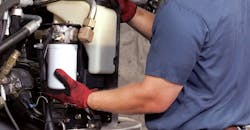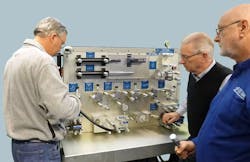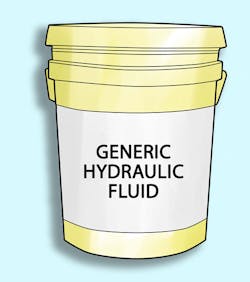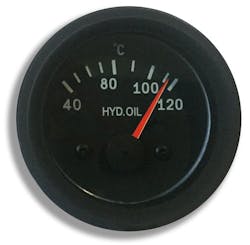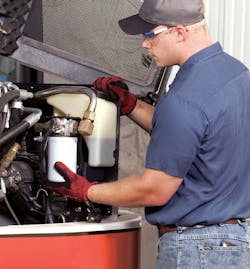During my three decades working in the hydraulics industry, I’ve been in the fortunate position of being able to observe—and learn from—the mistakes and omissions hydraulics users made when maintaining their equipment. Based on these long-term observations, I came up with seven most common mistakes hydraulic equipment users make, but don’t have to.
1. Not getting educated in hydraulics
The purpose of this article is to show that if you own, operate, repair or maintain hydraulic equipment and you aren’t aware of the latest hydraulic equipment maintenance practices, a lot of money can slip through your fingers. And we’re just scratching the surface here.
Whether you prefer in-plant or in-classroom learning, books, ebooks, DVDs, or online courses, it’s in your best interest (and your company’s) to gain a thorough understanding of hydraulic components, circuits, systems, and operation. You’ll save an unbelievable amount of time and money, and the hydraulic equipment you’re responsible for will last longer and operate more reliably.
2. Using the wrong hydraulic fluid
The hydraulic fluid is the most important component of any hydraulic system. Not only is hydraulic oil a lubricant, it is also the means by which power is transferred throughout the hydraulic system. It’s this dual role which makes viscosity the most important property of the oil, because it affects both machine performance and service life.
Oil viscosity largely determines the maximum and minimum oil temperatures within which the hydraulic system can safely operate. If you use oil with a viscosity that’s too high for the climate in which the machine must operate, the oil won’t flow properly or lubricate adequately during cold start. If you use oil with a viscosity too low for the prevailing climate, it won’t maintain the required minimum viscosity—and therefore, adequate lubrication—on the hottest days of the year.
But that’s not the end of it: Within the allowable extremes of viscosity required for adequate lubrication, there is a narrower viscosity band where power losses are minimized. If operating oil viscosity is higher than ideal, more power is lost to fluid friction. If operating viscosity is lower than ideal, more power is lost to friction and internal leakage.
Using the wrong viscosity oil not only results in lubrication damage and premature failure of major components, it also increases power consumption (diesel or electricity) – two things you don’t want.
And despite what you might think, you won’t necessarily get the correct viscosity oil by blindly following the blanket recommendations of the machine manufacturer.
3. Allowing Systems to Run at High Temperatures
Few equipment owners or operators continue to operate an engine that is overheating. Unfortunately, the same cannot be said when the hydraulic system gets too hot. But like an engine, the fastest way to destroy hydraulic components, seals, hoses, and the oil itself is high-temperature operation.
How hot is too hot for a hydraulic system? It depends mainly on the viscosity and viscosity index (rate of change in viscosity with temperature) of the oil, and the type of hydraulic components in the system.
As the oil’s temperature increases, its viscosity decreases. Therefore, a hydraulic system is operating too hot when it reaches the temperature at which oil viscosity falls below that required for adequate lubrication.
A vane pump requires a higher minimum viscosity than a piston pump, for example. This is why the type of components used in the system also influences its safe maximum operating temperature.
Apart from the issue of adequate lubrication, the importance of which cannot be overstated, operating temperatures above 82°C damage most seal and hose compounds and accelerate degradation of the oil. But for the reasons already explained, a hydraulic system can be running too hot well below this temperature.
4. Installing Filters in the Wrong Locations
Any filter is a good filter, right? Wrong! There are two hydraulic filter locations that do more harm than good and can rapidly destroy the very components they were installed to protect. These filter locations which should be avoided are the pump inlet and drain lines from the housings of piston pumps and motors.
This contradicts conventional wisdom: that it is necessary to have a strainer on the pump inlet to protect it from “trash.” First, the pump draws its oil from a dedicated reservoir, not a garbage can. Second, if you believe it’s normal or acceptable for trash to get into the hydraulic tank, then you’re probably wasting your time reading this article.
If getting maximum pump life is your primary concern (and it should be), then it’s far more important for the oil to freely and completely fill the pumping chambers during every intake than it is to protect the pump from nuts, bolts and 9/16-in. combination spanners. These pose no danger in a properly designed reservoir, where the pump inlet penetration is a least 2 in. off the bottom.
Research has shown that a restricted intake can reduce the service life of a gear pump by 56%. And it’s worse for vane and piston pumps, because these designs are less able to withstand the vacuum-induced forces caused by a restricted intake. Hydraulic pumps are not designed to “suck.”
A different set of problems arises from filters installed on the drain lines of piston pumps and motors, but the result is the same as suction strainers. They can reduce service life and cause catastrophic failures in these high-priced components.
5. Assuming hydraulic components are self-priming and self-lubricating
You wouldn’t start an engine without oil in the crankcase—not knowingly, anyway. And yet, I’ve seen the same thing happen to a lot of high-priced hydraulic components.
The fact is, if the right steps aren’t followed during initial start-up, hydraulic components can be seriously damaged. In some cases, they may work okay for a while, but the harm incurred at start-up then dooms them to premature failure.
There are two parts to getting this dilemma right: knowing what to do and remembering to do it. Not knowing what to do is one thing. However, if you do know, but forget to do it, that’s soul-destroying. You can’t pat yourself on the back for filling the pump housing with clean oil when you forgot to open the intake isolation valve before starting the engine!
6. Changing the Hydraulic Fluid
Only two conditions warrant a hydraulic oil change: degradation of the base oil or depletion of the fluid’s additives. Because so many variables determine the rate at which oil degrades and additives get used up, changing hydraulic oil based on hours in service, without any reference to the actual condition of the oil, is like shooting in the dark.
Considering the high price of oil, dumping oil that doesn’t need to be changed wastes time and money. Add to this disposal fees, and costs can really escalate. On the other hand, if you continue to operate with the base oil degraded or additives depleted, you compromise the service life of every other component in the hydraulic system.
The only way to know when the oil needs to be changed is through oil analysis. Sure, this takes time and costs money. But whether you use in a company offering fluid analysis services or invest in equipment and training analyze fluid in-house, the payoff can be huge. Not only will you avoid changing the fluid unnecessarily, but the analysis can reveal potential problems in the system before they become big and costly ones.
7. Changing Hydraulic Filters
A similar situation applies to hydraulic filters. If you change them based on schedule, you’re changing them either too early or too late. If you change them early, before all their dirt-holding capacity is used up, you’re wasting money on unnecessary filter changes. If you change them late, after the filter has gone on bypass, the increase in particles in the oil quietly reduces the service life of every component in the hydraulic system—costing a lot more in the long run.
The solution is to change your filters when all their dirt-holding capacity is used up, but before the bypass valve opens. This requires a mechanism to monitor the restriction to flow (pressure drop) across the filter element and alert you when this point is reached. A clogging indicator is the crudest form of this device. A better solution is continuous monitoring of pressure drop across the filter.
Brendan Casey is the founder of HydraulicSupermarket.com, frequent contributor to Hydraulics & Pneumatics, and the author of several books on hydraulic maintenance and troubleshooting A hydraulics specialist with an MBA, he has more than 25 years’ experience in the design, maintenance, and repair of mobile and industrial hydraulic equipment.
About the Author
Brendan Casey
Founder and author
Brendan Casey is the founder of HydraulicSupermarket.com and an author of several hydraulic maintenance and troubleshooting books. A hydraulics specialist with an MBA, he has more than 20 years experience in the design, maintenance and repair of mobile and industrial hydraulic equipment. Visit his website, www.hydraulicsupermarket.com, for more information.

Leaders relevant to this article:
